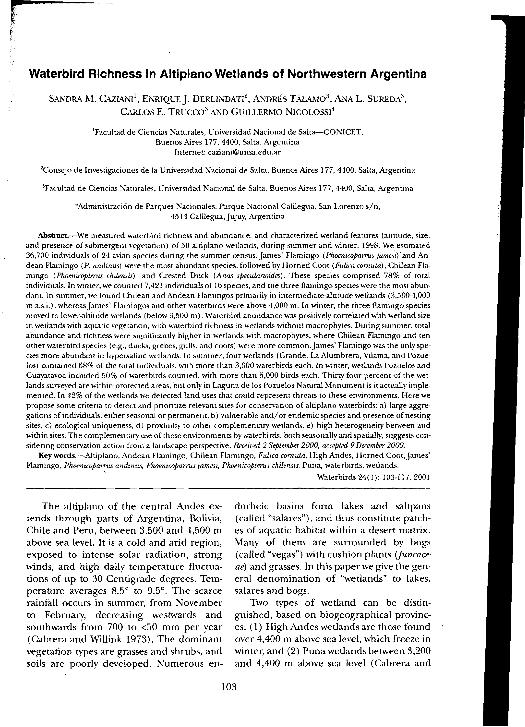Mostrar el registro sencillo del ítem
dc.contributor.author
Caziani, Sandra Monica

dc.contributor.author
Derlindati, Enrique Javier

dc.contributor.author
Tálamo, Andrés

dc.contributor.author
Sureda, Ana L.
dc.contributor.author
Trucco Aleman, Carlos Eduardo

dc.contributor.author
Nicolossi, Guillermo
dc.date.available
2021-03-24T02:06:05Z
dc.date.issued
2001-04
dc.identifier.citation
Caziani, Sandra Monica; Derlindati, Enrique Javier; Tálamo, Andrés; Sureda, Ana L.; Trucco Aleman, Carlos Eduardo; et al.; Waterbird richness in altiplano wetlands of northwestern Argentina; The Waterbird Society; Waterbirds; 24; 1; 4-2001; 103-117
dc.identifier.issn
1524-4695
dc.identifier.uri
http://hdl.handle.net/11336/128853
dc.description.abstract
We measured waterbird richness and abundance, and characterized wetland features (altitude, size, and presence of submergent vegetation) of 50 altiplano wetlands, during summer and winter, 1998. We estimated 36,700 individuals of 24 avian species during the summer census. James' Flamingo (Phoenicoparrus jamesi) and Andean Flamingo (P. andinus) were the most abundant species, followed by Horned Coot (Fulica cornuta), Chilean Flamingo (Phoenicopterus chilensis), and Crested Duck (Anas specularioides). These species comprised 78% of total individuals. In winter, we counted 7,421 individuals of 16 species, and the three flamingo species were the most abundant. In summer, we found Chilean and Andean Flamingos primarily in intermediate-altitude wetlands (3,500-4,000 m a.s.1.), whereas James' Flamingos and other waterbirds were above 4,000 m. In winter, the three flamingo species moved to lower-altitude wetlands (below 3,500 m). Waterbird abundance was positively correlated with wetland size in wetlands with aquatic vegetation, with waterbird richness in wetlands without macrophytes. During summer, total abundance and richness were significantly higher in wetlands with macrophytes, where Chilean Flamingo and ten other waterbird species (e.g., ducks, grebes, gulls, and coots) were more common. James' Flamingo was the only species more abundant in hypersaline wetlands. In summer, four wetlands (Grande, La Alumbrera, Vilama, and Pozuelos) contained 68% of the total individuals, with more than 3,000 waterbirds each. In winter, wetlands Pozuelos and Guayatayoc included 50% of waterbirds counted, with more than 5,000 birds each. Thirty four percent of the wetlands surveyed are within protected areas, but only in Laguna de los Pozuelos Natural Monument is it actually implemented. In 42% of the wetlands we detected land uses that could represent threats to these environments. Here we propose some criteria to detect and prioritize relevant sites for conservation of altiplano waterbirds: a) large aggregations of individuals, either seasonal or permanent, b) vulnerable and/or endemic species and presence of nesting sites, c) ecological uniqueness, d) proximity to other complementary wetlands, e) high heterogeneity between and within sites. The complementary use of these environments by waterbirds, both seasonally and spatially, suggests considering conservation action from a landscape perspective.
dc.format
application/pdf
dc.language.iso
eng
dc.publisher
The Waterbird Society

dc.rights
info:eu-repo/semantics/openAccess
dc.rights.uri
https://creativecommons.org/licenses/by-nc-sa/2.5/ar/
dc.subject
ALTIPLANO
dc.subject
ANDEAN FLAMINGO
dc.subject
CHILEAN FLAMINGO
dc.subject
FULICA CORNUTA
dc.subject
HIGH ANDES
dc.subject
HORNED COOT
dc.subject
JAMES FLAMINGO
dc.subject
PHOENICOPARNUS JAMESI
dc.subject
PHOENICORPARNUS ANDINUS
dc.subject
PHOERNICOPTERUS CHILENSIS
dc.subject
PUNA
dc.subject
WATERBIRDS
dc.subject
WETLANDS
dc.subject.classification
Ecología

dc.subject.classification
Ciencias Biológicas

dc.subject.classification
CIENCIAS NATURALES Y EXACTAS

dc.title
Waterbird richness in altiplano wetlands of northwestern Argentina
dc.type
info:eu-repo/semantics/article
dc.type
info:ar-repo/semantics/artículo
dc.type
info:eu-repo/semantics/publishedVersion
dc.date.updated
2021-03-15T14:41:02Z
dc.journal.volume
24
dc.journal.number
1
dc.journal.pagination
103-117
dc.journal.pais
Estados Unidos

dc.description.fil
Fil: Caziani, Sandra Monica. Universidad Nacional de Salta; Argentina. Consejo Nacional de Investigaciones Científicas y Técnicas. Centro Científico Tecnológico Conicet - Salta; Argentina
dc.description.fil
Fil: Derlindati, Enrique Javier. Consejo Nacional de Investigaciones Científicas y Técnicas. Centro Científico Tecnológico Conicet - Salta; Argentina
dc.description.fil
Fil: Tálamo, Andrés. Universidad Nacional de Salta; Argentina. Consejo Nacional de Investigaciones Científicas y Técnicas. Centro Científico Tecnológico Conicet - Salta; Argentina
dc.description.fil
Fil: Sureda, Ana L.. Universidad Nacional de Salta; Argentina
dc.description.fil
Fil: Trucco Aleman, Carlos Eduardo. Universidad Nacional de Salta; Argentina. Consejo Nacional de Investigaciones Científicas y Técnicas. Centro Científico Tecnológico Conicet - Salta; Argentina
dc.description.fil
Fil: Nicolossi, Guillermo. Administración de Parques Nacionales; Argentina
dc.journal.title
Waterbirds

dc.relation.alternativeid
info:eu-repo/semantics/altIdentifier/doi/https://doi.org/10.2307/1522249
dc.relation.alternativeid
info:eu-repo/semantics/altIdentifier/url/https://www.jstor.org/stable/1522249?seq=1
Archivos asociados
